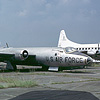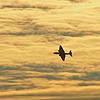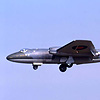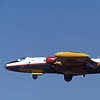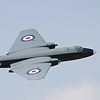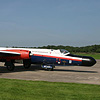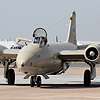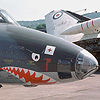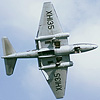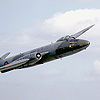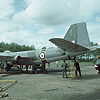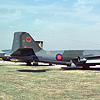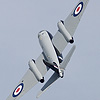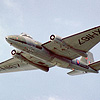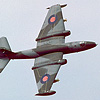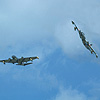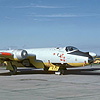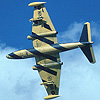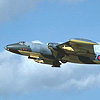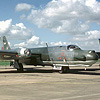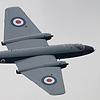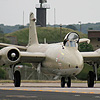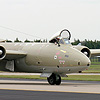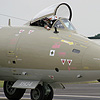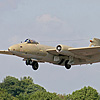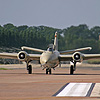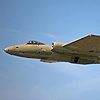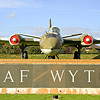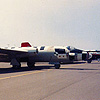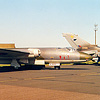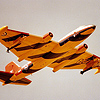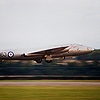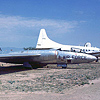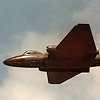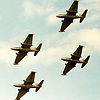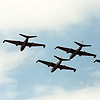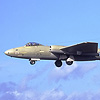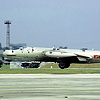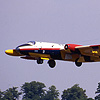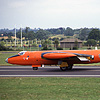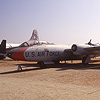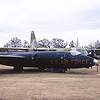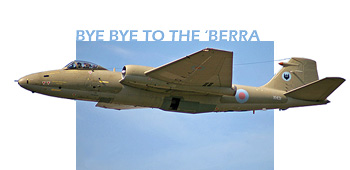
Canberra PR.9 Retirement Feature Report
Monday 31st July
It's hard to believe that an aircraft still flying well into the 21st century, in a vital front-line role with a major Western air arm, dates back to the latter years of the Second World War. The English Electric Canberra, which still serves the Royal Air Force with 39(1 PRU) Squadron at RAF Marham, began life on the drawing board as early as 1944, as Britain looked to replace it's ageing fleet of piston-engined Lancasters and Lincolns with the RAF's first jet-engined bomber aircraft. Few would have envisaged back then that Teddy Petter's sleek, graceful design would still be going strong until 2006.
With the Canberra in its final days of RAF service, pays tribute to an aircraft that can legitimately call itself a legend. Photography from the archives.
At first glance the uninitiated might think the Canberra, with twin Rolls-Royce Avon engines, looks rather like an upscaled Gloster Meteor, and certainly they're aircraft of a similar vintage. The "Meatbox" soon became outdated, and indeed the Canberra - which entered service in May, 1951 - was originally thought of as a 'stopgap' aircraft; a temporary measure until the more technically-advanced V-Bombers (and, later, it was hoped the TSR2) came online. The need for a jet bomber in the early post-war years was so pressing that 90 of them were ordered before a prototype had ever flown!
And yet while the Valiants, Vulcans and Victors have long since fallen to the scrapman's axe and blowtorch, the Canberra has soldiered on, outliving them all.
Few British designs have been exported quite so successfully as the Canberra. Air arms as far afield as Argentina, India and Venezuela operated the type, with many licence-built in the United States as the Martin B-57, and RB-57 reconnaissance type, including the RB-57D variant with extended wings - giving the aircraft the appearance of a rather bloated U-2! RB-57s still serve today in a photographic role with NASA.
In Britain, one Canberra survives airworthy and in civilian ownership - and she may be the most important Canberra of all. WK163 (G-BVWC), flown on the airshow circuit as part of the Coventry-based Air Atlantique Historic Flight, is a genuine record breaker. On August 28, 1957, flown by Mike Randrup, and assisted by a Scorpion rocket motor, WK163 set a world altitude record of 70,310ft - one of 19 records the Canberra set between 1949-58.
RAF Marham in West Norfolk is home to the remaining five operational RAF Canberras, which serve 39(1 PRU) Squadron (the last of an amazing total of over 60 RAF squadrons to have used the type). The fleet consists of four PR.9 photo-reconnaissance variants. These machines are XH131, XH134, XH135 and XH169. The sole-surviving airworthy T.4 continuation trainer is WJ874, though she wears the blue prototype scheme of VN799, and has done for the past five or so years.
Though she may be painted to represent the historic Canberra prototype, WJ874 has no mean lineage herself. This machine rolled off the English Electric production line on Christmas Eve, 1954 - giving her a service career spanning an amazing 51 years! It's fair to say the RAF have had value for money from this airframe.
In total some 770 Canberras of varying marks were built for the Royal Air Force, and the PR.9 is by far the longest-serving of them. The first PR.9 variant was flown on July 8, 1955, with the final one delivered to the squadrons in 1962. 39 squadron's association with this mark of Canberra stretches right back to 1960, which means that by the time the aircraft are finally retired in 2006, the squadron will have operated the PR.9 for a staggering 46 years. With aircraft technology over the past half century evolving at a rapid pace, very few machines can claim such longevity - the Douglas C-47 (soldering on until recently in Greece, with turboprop-engined versions still serving the South African Air Force) and Boeing B-52 Stratofortress (with the USAF) are among the select band of aircraft to have enjoyed such long and varied careers.
The Canberra has been tested in battle too - the jet got an early taste of combat when she was put to use as a bomber by the RAF in the Suez Crisis of 1956. Canberras have also flown combat sorties in war zones as varied as Vietnam and the Falklands. Recent active deployments for Marham's remaining PR.9s have included Rwanda, Kosovo and Afghanistan - the RAF's grand old lady is still a potent photographic reconnaissance weapon in her fifth decade of front line service.
So what replaces the Canberra? Without doubt it leaves a large hole in the RAF's inventory; in truth, the immediate replacement will not be as capable as the aircraft it is replacing. In the short-term, the photo-recon role will most likely be taken on by the RAPTOR reconnaissance pod equipped Panavia Tornado GR.4A (many are also based at Marham), but longer-term the solution may well be for an unmanned machine (UAV), along the lines of the US-built Global Hawk. Whatever fills the role will certainly not have the charisma of the Canberra.
The future for the Canberra may well include flying in civilian hands. We've already discussed Air Atlantique's stunning B.2 WK163. Three more currently fly in the United States. Firstly there's TT.18 WJ574 based at Van Nuys Airport in California. Two more (B.6 XH567 and B(I)8 WT327) operate for AirPlatforms Inc out of Lakeport, also in California, offering upper-atmosphere capability for scientific work. It remains to be seen if private warbird operators decide to keep one of the soon-to-be retired PR.9s in airworthy condition.
The problem in the UK could be that there simply isn't the demand for two civilian Canberras on the airshow circuit - and classic jets are immensely expensive to maintain and operate, a situation hardly helped by recent EU directives on insurance premiums. Another hope could be that a company like Hawker Hunter Aviation at Scampton, which already has an aerial armada of 12 Hunters, a Blackburn Buccaneer and Sukhoi Su-22 Fitter on charge, might find a place in its fleet for a Canberra. Certainly an aircraft with the PR.9's capability could be an attractive asset to such a company specialising in work with armed forces and defence contractors.
Time will tell what becomes of the remaining few airworthy Canberras, and while their retirement from military service is a sad occasion, the aviation community, as well as the wider world should be celebrating the wonderful career of a truly remarkable aircraft - and one we'll not see the like of again.

